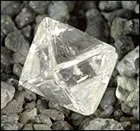 Diamond history transcends numerous cultures and localities. It is the oldest item that anyone can own. It is three billion years in age, a strategic and high tech super material that is formed in the earth’s interior and shot to the surface by extraordinary volcanoes. It is carbon in its most concentrated form, the chemical element fundamental to all life, thus it is a native element. It is also extremely pure, containing only trace amounts of boron and nitrogen. The diamond’s nearest relatives are mineral graphite and amorphous carbon.
Diamond history transcends numerous cultures and localities. It is the oldest item that anyone can own. It is three billion years in age, a strategic and high tech super material that is formed in the earth’s interior and shot to the surface by extraordinary volcanoes. It is carbon in its most concentrated form, the chemical element fundamental to all life, thus it is a native element. It is also extremely pure, containing only trace amounts of boron and nitrogen. The diamond’s nearest relatives are mineral graphite and amorphous carbon.
The ancient Greeks and Romans believed diamonds were tears of the Gods and splinters from falling stars. The Hindus attributed so much power to these precious stones they went so far as to place diamonds in the eyes of some of their statues.
 In unraveling the history and associations of diamonds, we also need to know the history of the words attached to it: did the words spoken by the Indians and Greeks signify the same things they do today, or something very different? These cultures associated tremendous value with these stones and clues as to why may be found in the language associated with them. “Diamond” comes from the Greek adamao, transliterated as “adamao,” “I tame” or “I subdue.” The adjective “adamas” was used to describe the hardest substance known, and eventually became synonymous with diamond.
In unraveling the history and associations of diamonds, we also need to know the history of the words attached to it: did the words spoken by the Indians and Greeks signify the same things they do today, or something very different? These cultures associated tremendous value with these stones and clues as to why may be found in the language associated with them. “Diamond” comes from the Greek adamao, transliterated as “adamao,” “I tame” or “I subdue.” The adjective “adamas” was used to describe the hardest substance known, and eventually became synonymous with diamond.
Knowledge of diamond origin starts in India where it was first mined. The first known reference to diamond is a Sanskrit manuscript, the Arthsastra (“The Lesson of Profit”) by Kautiliya, a minister to Chandragupta of the Mauryan dynasty (322 BC – 185 BC) in northern India.
Roman literature of the 1st century ad contains another early reference to diamond, and the diamonds known to the Romans undoubtedly came from India. India was for centuries the greatest source of diamonds in the world and is known for most of the famous historical diamonds. Although diamonds discovered in Borneo around 700 ad were an important source for Southeast Asia, India was the only source of diamonds known to Europeans until the 18th century. Europeans believed that diamonds were found only in the fabled mines of Golconda, near present-day Hyderâbâd. Golconda was in fact the market city of the diamond trade, and gems sold there came from a number of mines.
 Small numbers of diamonds began appearing in European regalia and jewelry in the 13th century, set as an accent point among pearls in splendid wrought gold. In the Middle Ages and Renaissance period, every ring that was set with a precious stone was not considered as much a piece of jewelry, as an amulet that bestowed magical powers like fearlessness and invincibility upon the wearer. Not only was it believed that diamonds could bring luck and success, but also that they could counter the effects of astrological events. There were many that wore diamonds as charms believing in their ability to heighten sexual prowess and attract others. Plato even wrote about diamonds as living beings, embodying celestial spirits. These myths laid the groundwork for monarchs to begin wearing diamonds as symbols of power.
Small numbers of diamonds began appearing in European regalia and jewelry in the 13th century, set as an accent point among pearls in splendid wrought gold. In the Middle Ages and Renaissance period, every ring that was set with a precious stone was not considered as much a piece of jewelry, as an amulet that bestowed magical powers like fearlessness and invincibility upon the wearer. Not only was it believed that diamonds could bring luck and success, but also that they could counter the effects of astrological events. There were many that wore diamonds as charms believing in their ability to heighten sexual prowess and attract others. Plato even wrote about diamonds as living beings, embodying celestial spirits. These myths laid the groundwork for monarchs to begin wearing diamonds as symbols of power.
An act of Louis IX of France (1214-1270) that established a sumptuary law reserving diamonds for the king bespeaks of the rarity of diamonds and the value conferred on them at that time. Within 100 years diamonds appeared in royal jewelry of both men and women, then among the greater European aristocracy.
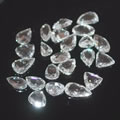 The earliest diamond-cutting industry is believed to have been in Venice, a trade capital, starting sometime after 1330. In 1456 Louis de Berqueur discovered how to cut facets of a diamond. Europeans began to trade diamonds on a regular basis early in the 15th century with the opening of trade routes to the east. By the 16th century the diamond became larger and more prominent as the result of the development of diamond faceting which enhances brilliance and fire.
The earliest diamond-cutting industry is believed to have been in Venice, a trade capital, starting sometime after 1330. In 1456 Louis de Berqueur discovered how to cut facets of a diamond. Europeans began to trade diamonds on a regular basis early in the 15th century with the opening of trade routes to the east. By the 16th century the diamond became larger and more prominent as the result of the development of diamond faceting which enhances brilliance and fire.
In the 17th and 18th centuries the diamond presided as the ultimate in representing all that was wealth, prestige and power, and the huge import of diamonds during this period was nothing short of revolutionary.
Until the 18th century India was the only known source of the stones, believed to be found only in the fabled mines of Golconda, though Golconda was in fact only the market city of the diamond trade and gems sold there came from a number of mines. Brazil then became the main producer after diamonds were found there in 1726.
The identification of a “pebble” picked up by a child on the banks of the Orange River in South Africa in 1866 as a 21-carat diamond precipitated the opening of diamond fields in that region. It was not until the 1867 discovery of diamonds near Hopetown, south of Kimberley in South Africa, that the modern diamond industry was born.
 The rush to search for alluvial diamonds in the gravel of the Orange and Vaal rivers greatly accelerated in 1870 and 1871 following the discovery of “dry diggings” in the district near present-day Kimberley. These diggings were roughly circular patches of yellow clay containing diamonds. As the miners dug deeper in the clay, often called “yellow ground,” they found a hard, bluish rock below it that also proved to be productive. This “blue ground,” a rock called kimberlite, is the parent material from which yellow ground is formed by weathering. Further mining disclosed that the circular areas of yellow and blue ground are the tops of funnel-shaped volcanic pipes of kimberlite. Prospectors have found similar pipes, not all of which contain diamonds, at various other locations in Africa and other continents.
The rush to search for alluvial diamonds in the gravel of the Orange and Vaal rivers greatly accelerated in 1870 and 1871 following the discovery of “dry diggings” in the district near present-day Kimberley. These diggings were roughly circular patches of yellow clay containing diamonds. As the miners dug deeper in the clay, often called “yellow ground,” they found a hard, bluish rock below it that also proved to be productive. This “blue ground,” a rock called kimberlite, is the parent material from which yellow ground is formed by weathering. Further mining disclosed that the circular areas of yellow and blue ground are the tops of funnel-shaped volcanic pipes of kimberlite. Prospectors have found similar pipes, not all of which contain diamonds, at various other locations in Africa and other continents.
South Africa quickly became the leading producer of diamonds in the world. During the late 19th century De Beers Consolidated Mines Ltd., led by British colonial statesman Cecil Rhodes, was formed there. To this day the De Beers cartel controls a large portion of the world’s natural diamond production.
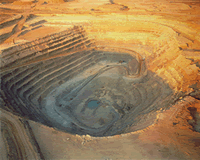 South Africa is still a leading producer of diamonds, but prospectors have found substantial diamond deposits, many of which are alluvial, in other parts of Africa, including Botswana, the Democratic Republic of the Congo (DRC, formerly Zaire), Tanzania, Ghana, and Sierra Leone. Other major present-day diamond producers are Australia, Siberia in Russia, Brazil, Venezuela, and Guyana.
South Africa is still a leading producer of diamonds, but prospectors have found substantial diamond deposits, many of which are alluvial, in other parts of Africa, including Botswana, the Democratic Republic of the Congo (DRC, formerly Zaire), Tanzania, Ghana, and Sierra Leone. Other major present-day diamond producers are Australia, Siberia in Russia, Brazil, Venezuela, and Guyana.
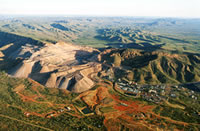 During the mid-nineteenth century, diamonds were also being discovered in eastern Australia. However, it was not until late 1970’s, after seven years of earnest searching, that Australia’s alleged potential as a diamond producer was validated. On October 2nd 1979, geologists found the Argyle pipe near Lake Argyle: the richest diamond deposit in the world. Since then, Argyle has become the world’s largest volume producer of diamonds and for many years was responsible for producing over a third of the world’s diamonds.
During the mid-nineteenth century, diamonds were also being discovered in eastern Australia. However, it was not until late 1970’s, after seven years of earnest searching, that Australia’s alleged potential as a diamond producer was validated. On October 2nd 1979, geologists found the Argyle pipe near Lake Argyle: the richest diamond deposit in the world. Since then, Argyle has become the world’s largest volume producer of diamonds and for many years was responsible for producing over a third of the world’s diamonds.
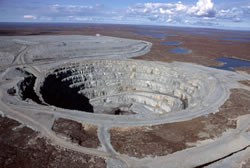
Canada has become the third largest diamond producer due to the discovery of diamond deposits in the Northwest Territories and Alberta during the mid- and late 1990s.
Smaller natural diamond deposits occur in China, Borneo, Myanmar, Thailand, and the Ural Mountains in Russia. Isolated stones have been found at various places in the United States, and a kimberlite pipe on the Colorado-Wyoming state line yields sufficient quantities for mining. Kimberlite diamonds also occur in Arkansas.
General Electric produced the first small synthetic diamonds of similar quality to natural industrial diamonds in 1955. Today, industrial-grade synthetic diamonds are inexpensively mass-produced.
